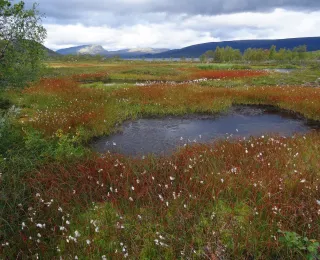Wetland conservation under the Ramsar Convention

Status of wetlands and associated threats
Since 1970, 35 percent of the world’s wetlands have disappeared. This is the alarming conclusion drawn by the Global Wetland Outlook, the global report on the status of wetlands. Natural wetlands are disappearing at an annual rate that is three times higher than that of natural forests . Also since 1970, 81 percent of animal and plant species reliant on freshwater wetlands have declined. The loss of wetlands and their biological diversity is largely driven by drainage and land-use change, extraction of water and other natural resources, infrastructure development, pollution by nutrients and contaminants, the spread of invasive alien species and the impacts of climate change.

The Ramsar Convention
The Convention on Wetlands (Ramsar Convention) was adopted as an intergovernmental treaty on 2 February 1971 in the city of Ramsar in Iran. World Wetlands Day has been celebrated every year on that day since 1997. The Ramsar Convention focuses on the conservation and sustainable use (“wise use”) of wetlands. Other important aspects include communication and education on the importance of wetlands and intergovernmental cooperation. Designation of “Wetlands of international importance” , also known as Ramsar sites, is an instrument used by the Convention to recognise particularly important wetlands in its member states.
Implementing the Ramsar Convention in Germany
Germany became a Contracting Party to the Ramsar Convention in 1976 and, with the designation of the Rosenheim Basin Bogs in 2021, now has a total of 35 Ramsar sites. BfN has assisted the implementation of the Ramsar Convention at both national and international level for many years. Among other things, BfN serves as the national focal point for the Convention’s Scientific and Technical Review Panel (STRP) and the Ramsar Programme on Communication, Capacity Building, Education, Participation and Awareness (CEPA).
One focus since the last Conference of the Contracting Parties (COP 14 in 2022) has been on the greater involvement of young people in the work of the Convention (Resolution XIV.12). Among other things, this has resulted in the establishment of a Youth Working Group. In addition, all Contracting Parties are called upon to nominate a national Ramsar Youth Focal Point to represent and advocate for the concerns of young people in the context of the Convention. Germany aims to fill this role on a volunteer basis for a period of two years. Applications from young people between the ages of 18 and 35 will be accepted until 31 October 2024.

Conservation, rewetting and wise use of peatlands in Europe and around the world
Peatlands cover only about three percent of the Earth’s land area, yet they store almost twice as much carbon as all of the forests combined. Drained peatlands, on the other hand, emit huge quantities of greenhouse gases. The Ramsar Convention has emphasised the particular importance of peatlands for natural climate protection, for example with its resolution in 2018. BfN supports international peatland conservation activities conducted under the Ramsar Convention, notably by holding exchange and networking events. These include two international workshops in 2019, one on exploring synergies for peatlands and the other on peatland strategies in Europe.

Riverine floodplains and coastal wetlands for biodiversity and the climate
Alongside peatlands, riverine floodplains and coastal wetlands can play an important role in natural climate protection and in adapting to the effects of climate change. They also provide valuable habitats for a wide range of animal and plant species. This is why riverine and coastal wetlands were selected as the focus for the European Conference on Biodiversity and Climate Change in 2023. In cooperation with the Network of European Nature Conservation Agencies (ENCA), it is the fifth successive conference that BfN has organised since 2011 to promote exchange and networking between European experts from science, policymaking and practice.
Using remote sensing for wetland management in Africa
In close cooperation with Ramsar Convention stakeholders in Africa, BfN has supported the use of remote sensing for wetland management. For example, managers can use freely accessible satellite data to classify wetlands, map land-use changes, assess risks and trends, and improve both planning and communication of the measures needed. Together with African experts, and as part of a BfN-supported project, a consultation and capacity development workshop was held and an English-language manual was also compiled.
